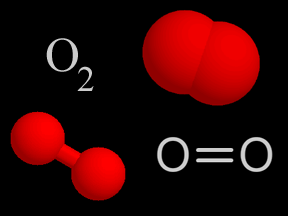Shown here are four representations chemists use for a molecule of ammonia. In the colored models, nitrogen atoms are blue and hydrogen atoms are white.
Click on image for full size
Windows to the Universe original artwork by Randy Russell.
Molecules
Most things around us are made of groups of atoms bonded together into packages called molecules. The atoms in a molecule are held together because they share or exchange electrons.
Molecules are made from atoms of one or more elements. Some molecules are made of only one type of atom. For instance, two oxygen atoms bond together to form the molecule O2, the part of the air that we need to breath to survive. Other molecules are very large and complex. Protein molecules, for example, often contain hundreds of atoms.
Other well known molecules include water, which is two hydrogen atoms bonded to one oxygen atom (H2O), and carbon dioxide, which is one carbon atom bonded to two oxygen atoms (CO2).
Each molecule is so small that you would not be able to see one molecule of a substance. But when thousands of molecules are together, they might look like a glass of water, a tree in the forest, or your computer screen, depending on what types of molecules they are.
A glass of water sitting on a table might look pretty still, but the molecules of water (H2O) and glass (Si) are moving all the time. In fact, though too small to see, all molecules are always moving and they will move faster as temperature increases.
You might also be interested in:

Everything you see around you is made of tiny particles called atoms, but not all atoms are the same. Different combinations of protons , neutrons and electrons make different types of atoms and these
...more
Oxygen is a chemical element with an atomic number of 8 (it has eight protons in its nucleus). Oxygen forms a chemical compound (O2) of two atoms which is a colorless gas at normal temperatures and pressures.
...more
Chemistry is the study of matter, energy, and their interactions. Chemists study the composition of substances, their properties, and how they react with each other under varying circumstances. Indeed,
...more
Elements make up everything around us including the trees of a forest, your pets, and even YOU! If you looked at living things with a microscope, you would see that all life is made up of small compartments
...more
The periodic table on the left separates the elements into three groups: the metals (green in the table), nonmetals (orange), and metalloids (blue). Most elements are metals. They are typically shiny,
...more
Even though there are 92 elements that naturally occur, only eight of them are abundant in the rocks that make up the Earth’s outer layer, the crust. Together, these 8 elements account for 98.5% of the
...more
The thermosphere is a layer of Earth's atmosphere. The thermosphere is directly above the mesosphere and below the exosphere. It extends from about 90 km (56 miles) to between 500 and 1,000 km (311 to
...more













